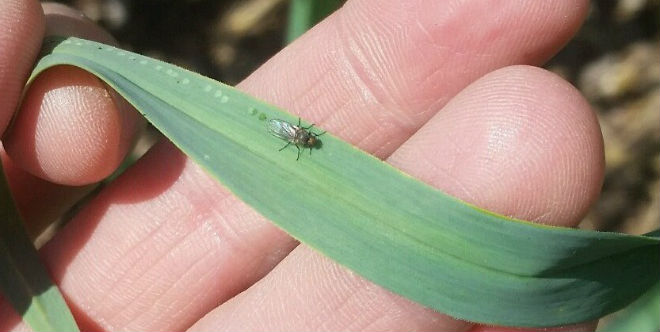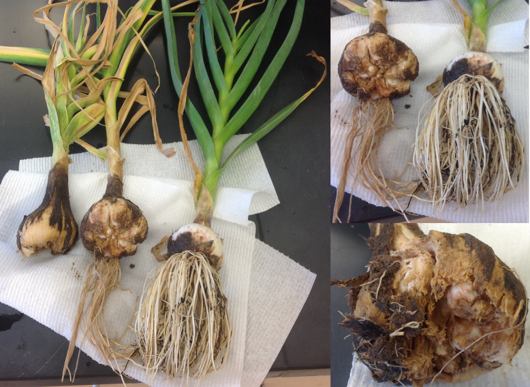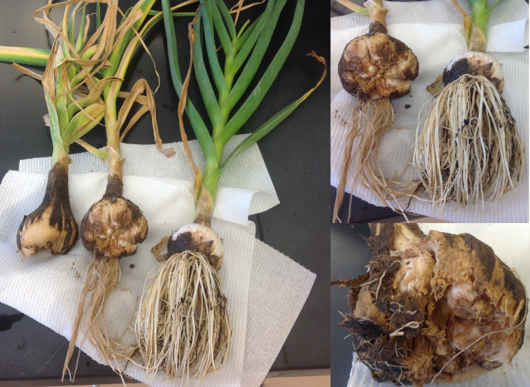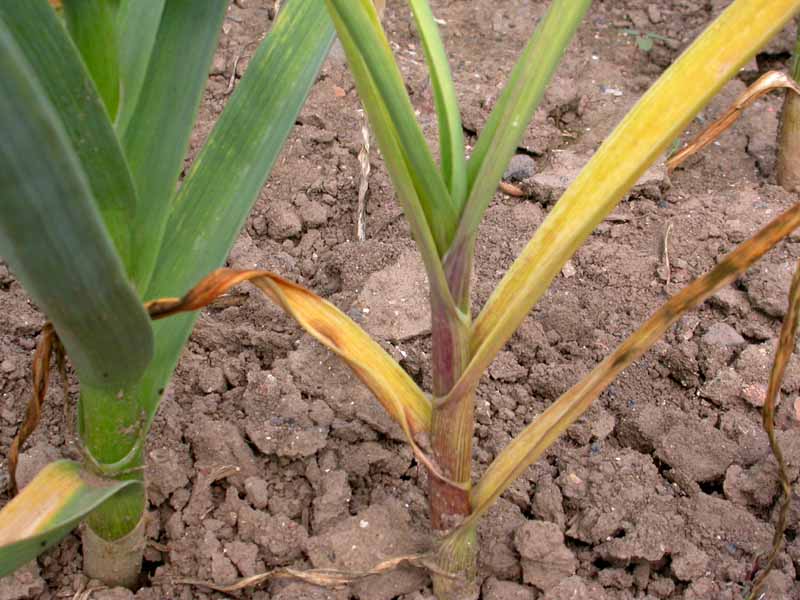- Affected plants during the growing season to be withdrawn and destroyed.
- Spray Wapkill (Acitamprid) @ 100 gm/acre or
- Confidor(Imidacloprid ) @ 100 ML/acre or
- Evident (Thaimethoxam ) @ 5 gm/pump or
- Abacin (Abamectin 1.8% EC) @ 150 ML
Nutrient management on garlic after 25 day
- Micronutrients are also effective in increasing the yield of garlic crops.
Given nutrient sequence are apply –
Nutrition Dose (15 DAS)
- Bulk Fetilizer Urea @ 20 Kg/acre + 12:32:16 @ 20 Kg/acre + Vigore @ 300gm/acre
Nutrition Dose (30 DAS)
- Urea @ 20 Kg/acre + Maxgrow @ 8 kg/acre
Nutrition Dose (50 DAS)
- Calcium Nitrate @ 6kg/acre + Zinc sulphate @ 8 kg/acre
Irrigation management on garlic
- First irrigation is given just after planting.
- Repeat irrigation 3 days after for ensuring germination.
- Irrigate as per need.
- Thereafter irrigate ones in a week during the vegetative phase and 10-15 days during bulb development
- Avoid irrigation during bulb maturity. Irrigate 2-3 days before harvest to facilitate easy uprooting.
White fly in Garlic
- Nymphs and adults suck the cell sap from the leaves.
- The affected leaves curl and dry.
- The affected plants show stunted growth.
Like and share with other farmers by clicking on the button below
ShareControl of Eriophyid mite in Garlic and Onion
- Both adults and immatures feed on the young leaves and between the layers in cloves of Garlic and Onion. Leaves do not open completely.
- The whole plant shows stunting, twisting, curling, and yellow mottling. Mottling is seen mostly on the edges of the leaves.
- Acaricides like Sulphur 80% WP@ 3 Gm per liter of water gives effective control of mites.
- Twice spraying of Propargite 57% EC @ 400 ml/Acre in 7 days interval helps in controlling the pest in the initial stage.
Like and share with other farmers by clicking on the button below.
ShareStem and bulb nematode in Onion and Garlic
Stem and bulb nematode in Onion and Garlic:- Nematode enters through stoma or plant wounds and create galls or malformations in plant growth. This allows for the entrance of secondary pathogens like fungi and bacteria. Symptoms are stunted growth, discoloration of bulbs, and swollen stems.
Management:-
- Bulbs that show signs of disease should not be planted.
- Proper sanitation of fields and tools is essential because this nematode can survive and reproduce in infected plants and residues.
- Apply Carbofuron 3% Granular @ 10 kg/ acre in the soil for better control of Nematodes.
- Apply Neem Cake @ 200 Kg/ Acre in the soil for organic control of Nematodes.
Like and share with other farmers by clicking on the button below
ShareWeed control in Garlic
Weed control in Garlic:-
- Application of Pendimethalin 38.7% CS @ 100ml/15 litre of water or Oxyfluorfen 23.5 EC @ 15ml/15 litre of water or Oxadiargyl 80% WP @ 12 gm/ 15 litre of water at 3 days after planting are recommended for effective weed control in Garlic along with one weeding by hand at 25-30 days after planting and second hand weeding 40-45 Days After Planting in crop.
- The use of rice straw mulch or wheat straw mulch is recommended to enhance the yield also.
- The combined application of Oxyfluorfen 23.5 % EC @ 1ml/l + quizalofop ethyl 5 % EC @ 2 ml/L at 20-25 days after planting and having at 30-35 days after planting good control of weed and higher bulb yield.
Like and share with other farmers by clicking on button below.
ShareManagement of Fusarium basal rot/basal rot
- Tricoderma @ 6 Kg/acre
- Carbendezim + mancozeb ( Saaf/Turf ) @ 1kg/acre or
- Kitazine @ 1 ltr/acre. or
- Conika (Kasugamycin 5% + Copper Oxychloride 45% ) WP @ 300 gm/acre. or
- Trigger Pro (Hexaconazole 5% SC) @ 400 ML/acre + Streptocycline (Streptomycin Sulphate IP90%W/W+Tetracycline Hydrochloride IP 10%W/W) @ 12 gm/acre
Fusarium rot/basal rot in garlic
- Initially yellowing of leaves and stunted growth of the plant is observed, which later on dry from tip to downwards.
- In the early stage of infection, the roots of the plants become pink in colour and rotting take place later. In the advanced stage, the bulb starts decaying from lower ends and ultimately the whole plant dies.
- Survival and spread:- Pathogen survives in soil and garlic bulb as a primary source of inoculum in the form of Chlamydospore, resting spore) for many years.
- Favourable conditions:- Moist soil and 27 °C temperature favours the development of disease.
Sowing time, Planting and Seed Rate of Garlic
- Cloves are sown in September-November in central India.
- The selection of cloves is important for garlic planting.
- Individual cloves from seed garlic bulbs should be separated but not long before planting.
- Twist off the outer skins and take the cloves apart without breaking the basal plate of the cloves, as that makes them unusable for planting.
- With hardneck garlic, the remainder of the stem acts as a handy lever for separating the cloves.
- Big cloves (>1.5g) should be selected for planting. Small, diseased and damaged cloves should be rejected.
- The seed rate for garlic is 160-200 kg/acre.
- Selected cloves should be planted vertically 2 cm below the soil surface with the plant to plant spacing of 10 cm and row to row spacing of 15 cm.
Like and share with other farmers by clicking on the button below
Share








